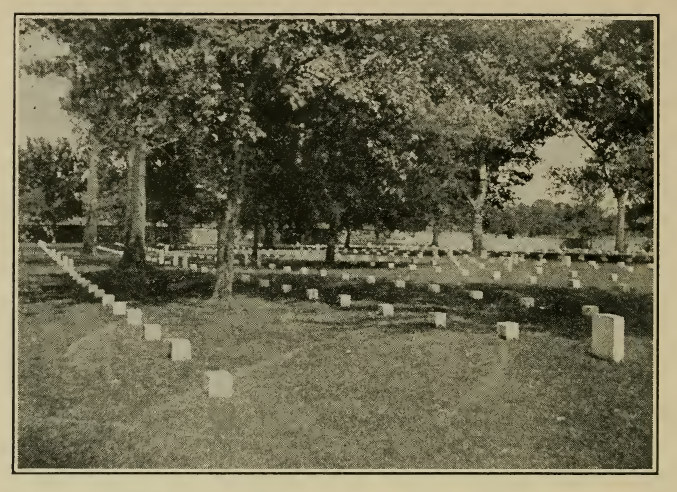 |
NATIONAL CEMETERY AT FORT GIBSON
THE BIVOUAC OF THE DEAD |
The muffled drum’s sad roll has beat the soldier’s last tattoo;
No more on life’s parade shall meet that brave and fallen few.
On Fame’s eternal camping ground their silent tents are spread,
While Glory guards, with solemn round, the bivouac of the dead.
No rumors of the foe’s advance now swells upon the wind;
No troubled thought at midnight haunts of loved ones left behind;
No vision of the morrow’s strife the warrior’s dream alarms;
No braying horn or screaming fife at dawn shall call to arms.
Their shivered swords are red with rust; their plumed heads are bowed;
Their haughty banner, trailed in dust, is now their martial shroud.
And plenteous funeral tears have washed the red stains from each brow,
And the proud forms by battle gashed are free from anguish now.
The neighing troop, the flashing blade, the bugle’s stirring blast.
The charge," the dreadful cannonade, the din and shout are past;
Nor war’s wild note, nor glory’s peal, shall thrill with fierce delight
Those breasts that nevermore may feel the rapture of the fight.
Rest on, embalmed and sainted dead! dear as the blood ye gave,
No impious footstep here shall tread the herbage of your grave;
Nor shall your story be forgot while Fame her record keeps,
Or Honor points the hallowed spot where Valor proudly sleeps.
Yon marble minstrel’s voiceless stone in deathless song shall tell,
When many a vanished age hath flown, the story how ye fell;
Nor wreck, nor change, nor winter’s blight, nor time’s remorseless doom
Shall dim one ray of glory’s light that gilds your deathless tomb. |
| —Theodore O’Hara. |
| SIXTH PERIOD. |
| (1865-1875) |
| PEACE RESTORED—PLAINS TRIBES AT WAR |
| New Treaties Made.— having failed to agree as to the terms of new treaties at their general council at Fort Smith (September, 1865), the civilized tribes sent representatives to Washington early the following year, again to take the matter up with the Government. All of the civilized tribes agreed to new treaties during the spring and summer of 1866. |
Terms of the Treaties. —All of these treaties provided:
(1) that there should be no more slavery among the Indians;
(2) that the Government might have the right to permit the construction of railway lines across the tribal reservations;
(3) for the union of the tribes of the Indian Territory with a general legislative council the members of which were to be apportioned according to population;
(4) for the settlement of other or friendly Indians in the Territory, and
(5) for a general amnesty and forgiveness of all acts and deeds committed as acts of war between 1861 and 1865. In addition, each treaty contained some provisions which did not appear on the others. |
| The Freed Slaves. —The Cherokee Council (Union) had voluntarily abolished slavery in the Cherokee Nation by legislative enactment in February, 1863. Under the terms of the new treaties, the Cherokee, Creek and Seminole nations granted the freed slwes full tribal citizenship rights, including lands and annuities. In the Choctaw and Chickasaw nations the freedmen were granted citizenship but no share in annuities or trust funds and only forty acres of land each. |
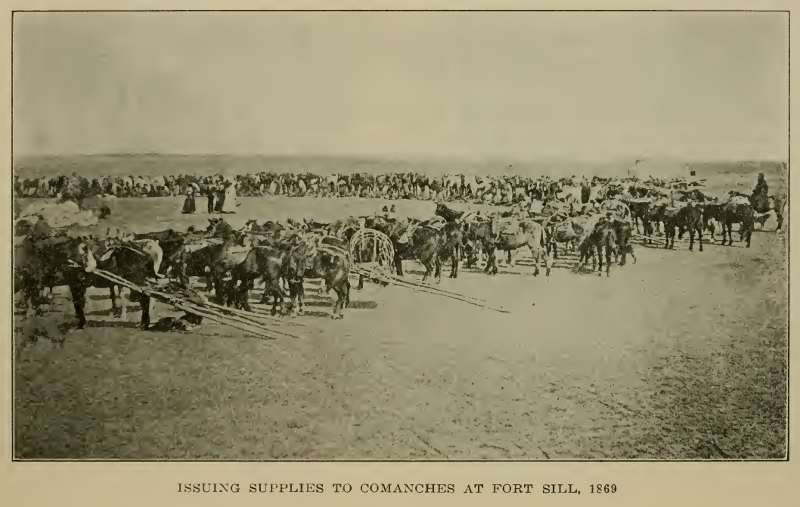 |
| Tribes from Kansas Moved to the Territory. —In 1867 and 1868 a number of tribes of Indians moved from Kansas and settled in the Indian Territory after disposing of their reservations in that state. The Caddoes, Wichitas, and other tribes which had gone north to Kansas during the early part of the Civil War, also returned to their reservations on the Washita. |
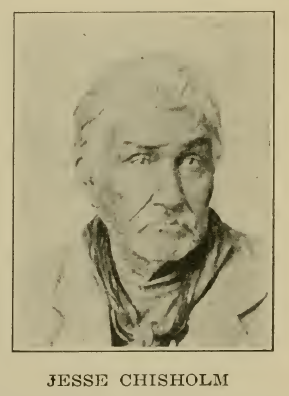 The Chisholm Trail and the Overland Cattle Trade. — The Chisholm Trail was a wilderness road which was first marked by the wheel tracks of Jesse Chisholm’s wagons as he passed southward from the site of Wichita, Kansas, to the old Caddo-Wichita Agency, near the present town of Anadarko, in the spring of 1865. Two years later, in the spring of 1867, the first herds of Texas cattle were driven northward to Abilene, Kansas, over the Chisholm Trail, for shipment to Chicago. During the ensuing twenty years, the Chisholm Trail bore an important part in the history of the western part of the Indian Territory. It was not only a highway of traffic and travel by wagon and stage coach, but it was also the route over which millions of cattle slowly grazed toward the shipping station and market. The Chisholm Trail and the Overland Cattle Trade. — The Chisholm Trail was a wilderness road which was first marked by the wheel tracks of Jesse Chisholm’s wagons as he passed southward from the site of Wichita, Kansas, to the old Caddo-Wichita Agency, near the present town of Anadarko, in the spring of 1865. Two years later, in the spring of 1867, the first herds of Texas cattle were driven northward to Abilene, Kansas, over the Chisholm Trail, for shipment to Chicago. During the ensuing twenty years, the Chisholm Trail bore an important part in the history of the western part of the Indian Territory. It was not only a highway of traffic and travel by wagon and stage coach, but it was also the route over which millions of cattle slowly grazed toward the shipping station and market.
Proposed Territorial Organization. —During the winter of 1866-7, Representative R. T. Van Horn, of the Kansas City (Missouri) district, introduced a bill in Congress, the object of which was to provide an organized territorial government for the Indian Territory. The bill was never discussed on the floor of the House of Representatives, though it occasioned considerable interest at the time. |
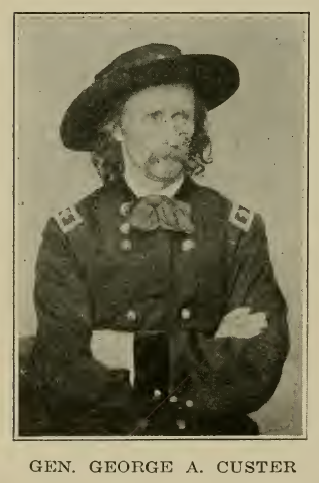 War With the Tribes of the Plains.— Throughout the period of the Civil War, most of the Indians of the wild tribes of the Southern Plains region (i, e., Comanches, Kiowas, Apaches of the Plains, Arapahoes and Cheyennes) were on the warpath. In October, 1865, the chiefs and head men of these tribes were induced to sign treaties at the peace council which was held at the mouth of the Little Arkansas River (Wichita, Kansas). Peace lasted through the following winter and spring. Then war broke out on the Plains again. Frontier forts and military posts which had been abandoned at the outbreak of the Civil War were reoccupied and many new ones were established and the war was vigorously pushed by the government. In October, 1867, a great peace council was held in the valley of the Medicine Lodge River, in Southern Kansas, at which new treaties were signed. By the terms of these treaties, the Indians of all of these tribes agreed to accept reservations in the western part of the Indian Territory. It was hoped that there would be no more Indian war in the country bordering on the Great Plains, but the next year many of the wild tribes were again off their reservations and on the warpath. War With the Tribes of the Plains.— Throughout the period of the Civil War, most of the Indians of the wild tribes of the Southern Plains region (i, e., Comanches, Kiowas, Apaches of the Plains, Arapahoes and Cheyennes) were on the warpath. In October, 1865, the chiefs and head men of these tribes were induced to sign treaties at the peace council which was held at the mouth of the Little Arkansas River (Wichita, Kansas). Peace lasted through the following winter and spring. Then war broke out on the Plains again. Frontier forts and military posts which had been abandoned at the outbreak of the Civil War were reoccupied and many new ones were established and the war was vigorously pushed by the government. In October, 1867, a great peace council was held in the valley of the Medicine Lodge River, in Southern Kansas, at which new treaties were signed. By the terms of these treaties, the Indians of all of these tribes agreed to accept reservations in the western part of the Indian Territory. It was hoped that there would be no more Indian war in the country bordering on the Great Plains, but the next year many of the wild tribes were again off their reservations and on the warpath. |
| A Winter Campaign. —Throughout the summer and fall of 1868, the troops stationed in Western Kansas, Eastern Colorado, Eastern New Mexico and Western Texas were kept in almost constant pursuit of bands of Indian warriors who were raiding settlements and attacking coaches and wagon trains on the overland trails. It was finally decided that a winter campaign should be undertaken. Gen. George A. Custer was placed in command of the troops in the field for this purpose. Organizing part of his expedition at Fort Dodge, Kansas, General Custer moved southward in November, 1868, to the North Canadian River, in the Indian Territory, where Camp Supply was established. A few days later, in command of his own regiment, (Seventh U. S. Cwalry) General Custer marched on south to the valley of the Washita, where he found and attacked the village of the Cheyenne chief. Black Kettle, November 27, 1868. This chief and most, of his warriors were killed and a large |
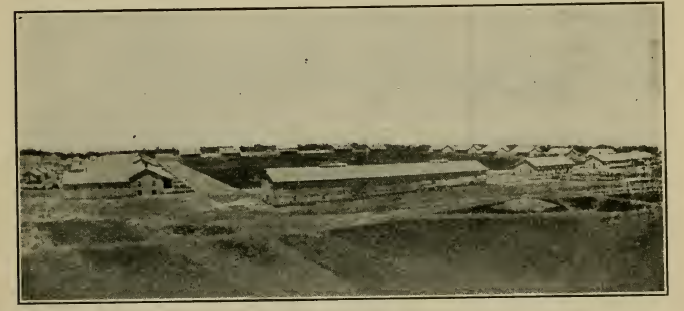 |
| FORT SILL IN 1871 |
| number of prisoners were taken. The campaign was continued throughout the winter and the following spring found most of the Indians staying on their reservations. Two new military posts were established as the result of this campaign, namely, Camp Supply and Fort Sill. |
| Progress Toward Peace.— Several of the tribes of the Plains region showed a willingness to settle down on their reservations and remain at peace. These included the Arapahoes, Plains Apaches and one band of the Comanches (Peneteka). Most of the Cheyennes and Kiowas were sullen and dissatisfied and one band of the Comanches (Quahada) refused to be bound by any treaty whatever and persisted in remaining off of the reservation and in raiding settlements and stealing horses in Texas. |
| The Quaker Agents. |
| About the time that the campaign on the Washita was in progress, a committee representing the Society of Friends, called on Gen. U. S, Grant, who had recently been elected to the presidency, and asked him to consider the propriety of appointing religious men as Indian agents—agents who would as far as possible, secure upright, moral men as agency employees—in the certain belief that the effect |
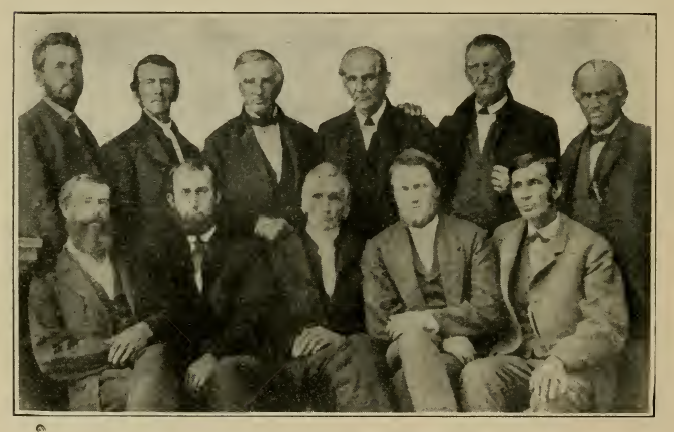 |
| THE QUAKER AGENTS |
on the Indians would be much better than that which commonly prevailed at the time. After listening to the deputation with great interest. General Grant replied: “Gentlemen, your advice is good. Now give me the names of some Friends for Indian agents and I will appoint them. Let us have peace.” Such ready acquiescence to the spirit of their petition from the victorious warrior was a real surprise to the peaceful followers of Fox. As the result of their recommendations. President Grant appointed ten Friends (or Quakers) as Indian agents in the spring of 1869. Among these were Lawrie Tatum, agent for the Comanches, Kiowas, and Apaches, Brinton Darlington, agent for the Cheyennes and Arapahoes, and Thomas Miller, agent for the Sac and Fox, Absentee Shawnees, Pottawatomies and Kickapoos. Quaker agents were also appointed for Wichitas, Caddoes and affiliated tribes, the Kansas (or Kaws) and the Osages in 1870-71-72.
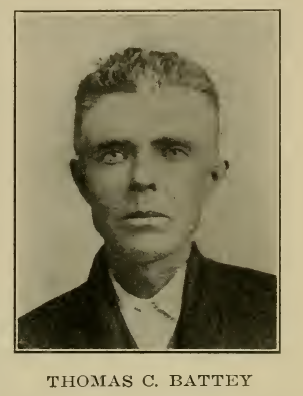 Thomas C. Battey, a Quaker school teacher, was employed in conducting a school at the Wichita Agency. Kicking Bird asked him to go to the camp of his band and conduct a school. Agent Tatum favored the plan, and the Commissioner of Indian Affairs finally approved it. In December, 1872, he went out to the Kiowa camp to open a school for the children of Indians who were still living in a state of primitive savagery. He was supplied with a wagon and a long tent, which was used as a school room. With this equipment Battey accompanied the Kiowas in the frequent changes of their village locations during a period of over eighteen months. As an educational experiment it was not a pronounced success, but the presence of the kind-hearted and peaceful teacher among them had a splendid effect upon the restless and turbulent spirits of the Kiowas. He kept a daily journal of his observations and experiences among the Kiowas, much of the contents of which afterward appeared in his book, entitled "A Quaker Among the Indians." Thomas C. Battey, a Quaker school teacher, was employed in conducting a school at the Wichita Agency. Kicking Bird asked him to go to the camp of his band and conduct a school. Agent Tatum favored the plan, and the Commissioner of Indian Affairs finally approved it. In December, 1872, he went out to the Kiowa camp to open a school for the children of Indians who were still living in a state of primitive savagery. He was supplied with a wagon and a long tent, which was used as a school room. With this equipment Battey accompanied the Kiowas in the frequent changes of their village locations during a period of over eighteen months. As an educational experiment it was not a pronounced success, but the presence of the kind-hearted and peaceful teacher among them had a splendid effect upon the restless and turbulent spirits of the Kiowas. He kept a daily journal of his observations and experiences among the Kiowas, much of the contents of which afterward appeared in his book, entitled "A Quaker Among the Indians." |
| The First Railways in the Indian Territory. —June 6, 1870, the first railway to enter the Indian Territory (the Missouri, Kansas & Texas) began laying its track southward from the Kansas boundary in the valley of the Neosho |
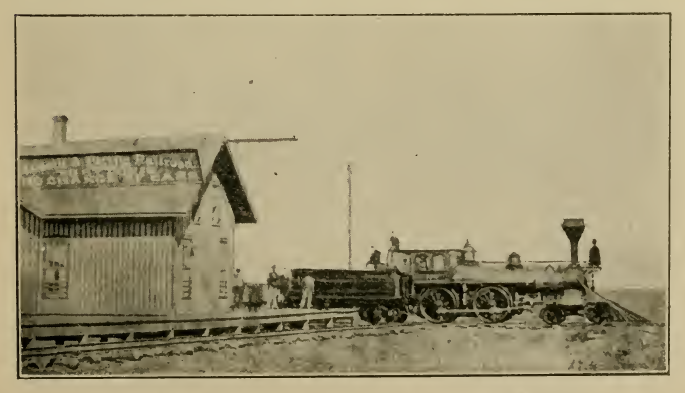 |
| RAILWAY STATION AND A. & P. LOCOMOTIVE AT VINITA, IN 1877 |
River. During 1871 and 1872 its construction was pushed southward and southwestward across the Cherokee, Creek and Choctaw nations and thence across the Red River into Texas. The Atlantic & Pacific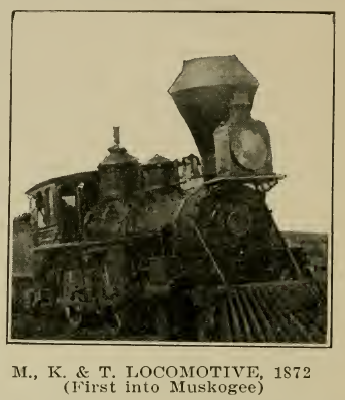 Railway built its line across the Shawnee and Wyandotte reservations, entering the Cherokee Nation, and effecting a junction with the Missouri, Kansas & Texas at Vinita, in 1872. Railway built its line across the Shawnee and Wyandotte reservations, entering the Cherokee Nation, and effecting a junction with the Missouri, Kansas & Texas at Vinita, in 1872.
A Race for a Right-of-Way. — Congress had passed an act (approved July 25, 1866), granting a conditional right-of-way across the Indian Territory, from Kansas to Texas, to the railway company which should be the first to complete its track to the state boundary line in the valley of the Neosho. An exciting race between the tracklayers of two rival companies took place during the early part of 1870, ending in a victory for the Missouri, Kansas & Texas.
The Okmulgee Constitution. —The first of a series of yearly inter-tribal councils w^as held at Okmulgee, December 5-11, 1870. After much discussion the council voted to appoint a committee to draft a constitution for a confedera-ation of the tribes of the Indian Territory. This committee, of which William P. Ross of the Cherokee Nation, was chairman, proceeded at once to perform the work assigned to it. The constitution which was framed by the committee provided for a confederation of all of the tribes of Indians in the Territory to be republican in form. All tribes were to be represented in the council in proportion to their populations. This constitution was submitted to thie various tribes but was not ratified and adopted. |
| Peace Council and War Party.— In May, 1871, while the representatives of more than a dozen tribes (including several of the civilized tribes) were helping the Government hold a peace council at Anadarko, a war party of Kiowas went on a raid into Texas where a government wagon train was attacked and the wagon-master and six teamsters were killed. The leaders of this war party were Satanta and Satank. They were afterward arrested, to be sent to Texas for trial. |
| Defeat of the Quahada Comanches. —In the fall of 1872, Col. Ranald S. McKenzie with a force of troops followed a raiding party to the Quahada Comanche camp, in the Texas Panhandle country, surprised and captured it with most of the women and children. Shortly afterward the Quahadas visited the Agency (at Fort Sill) for the first time. |
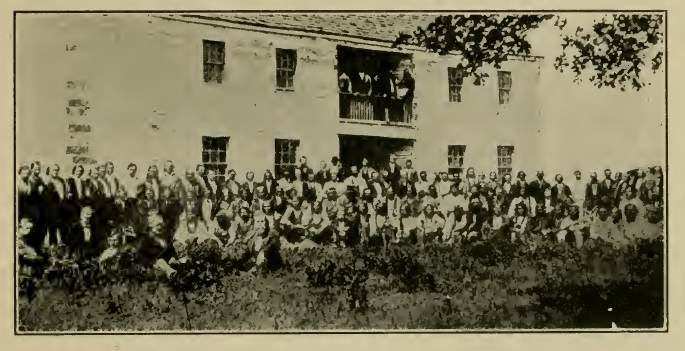 |
INTER-TRIBAL COUNCIL, OKMULGEE
(Thirty Tribes Represented) |
| First Coal Mines Opened.— The building of the first railway led to the opening of the first coal mines in the Indian Territory, at McAlester, shortly after the completion of the railway to that point, in 1872. |
| Outlaw Activities in the Indian Territory. —The lawless element was never more numerous and active in the Indian country than it was during the ten years immediately following the Civil war. Horse thieves, whiskey peddlers, gamblers and sharpers continually intruded upon the reservations, ever ready to prey upon the Indians. The white hunters killed thousands of buffalo for the mere wanton “sport” of killing, despite the protests of the Indians and the promises of the Government peace commissioners to the contrary. The raids of the white horse thieves and the wholesale slaughter of the buffalo angered the Indians to the point of hostility and was the cause of more than one outbreak. Thus, the innocent settlers on the frontiers of Kansas and Texas suffered on account of the misdeeds of outlaws and renegades in the Indian country. The lawless whites made the work of the Government tribal agents (most of whom were Quakers) doubly difficult. |
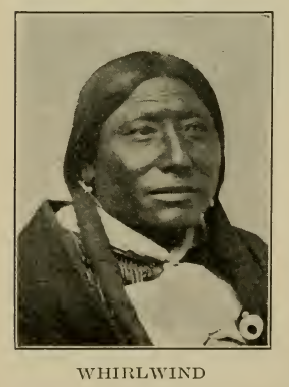 The Last General Outbreak. —A great many of the Indians of Western Oklahoma were becoming restless for various reasons. The Cheyennes wanted to go on the warpath in 1873 but neither the Comanches nor the Kiowas could join them as they had to be on their good behavior until their captive friends were released. So the last general Indian war did not come until 1874. Even then, there were many Indians who refused to join in making war on the whites. Most of the Comanches were hostile but the greater part of the Kiowas, under the influence of Kicking Bird, refused to leave the reservation. Whirlwind, a leading Cheyenne chief, brought his people to the Agency (Darlington) and refused to take part in the war. None of the Arapahoes and none of the Plains Apaches left their reservations. The war lasted not only WHIRLWIND through the summer and fall, but also all of the following winter. In the end, the hostile Indians were worn out and disheartened as they had never been before and the peace which followed was a lasting one. It was the last great Indian war east of the Rocky Mountains and south of the Dakotas. The Last General Outbreak. —A great many of the Indians of Western Oklahoma were becoming restless for various reasons. The Cheyennes wanted to go on the warpath in 1873 but neither the Comanches nor the Kiowas could join them as they had to be on their good behavior until their captive friends were released. So the last general Indian war did not come until 1874. Even then, there were many Indians who refused to join in making war on the whites. Most of the Comanches were hostile but the greater part of the Kiowas, under the influence of Kicking Bird, refused to leave the reservation. Whirlwind, a leading Cheyenne chief, brought his people to the Agency (Darlington) and refused to take part in the war. None of the Arapahoes and none of the Plains Apaches left their reservations. The war lasted not only WHIRLWIND through the summer and fall, but also all of the following winter. In the end, the hostile Indians were worn out and disheartened as they had never been before and the peace which followed was a lasting one. It was the last great Indian war east of the Rocky Mountains and south of the Dakotas. |
| Summary. —Because of the thrilling events which transpired in Oklahoma and especially in the western portion, during the years between 1865 and 1875, and also because of the fame of some of the men who were connected with those events, that period of the history of Oklahoma will always have a most romantic interest to the people of the state. The annals of the five civilized tribes during the same period are less exciting, as might be expected of a people who were recovering from the shock and exhaustion of participation in the Civil War. |
| SUGGESTIVE QUESTIONS Sixth Period. |
| 1. Briefly review the treaties by which the five civilized tribes renewed their severed relations with the Federal government. What changes in the conditions formerly existing in the Territory were made possible by these treaties? What Indian tribes were removed from Kansas to the Territory after these treaties went into effect? |
| 2. What was the Chisholm Trail? Why was it so named? |
| 3. When was the Van Horn Bill introduced into Congress? What was its purpose? |
| 4. What great Indian peace council was held in the autumn of 1867? What tribes were represented? What was the result of the negotiations which were conducted there? |
| 5. How long did the wild Indians remain at peace after the Medicine Lodge treaties? Tell about the military campaign in the winter of 1868-9. Where was the Battle of Washita fought? Who commanded the troops in that engagement? |
| 6. When were the first railways built in the Indian Territory? When were the first coal mines opened? |
| 7. What was the Okmulgee constitution? By whom was it formulated? How was it received and what were the results of the agitation? |
| 8. What military posts were established in Oklahoma during this period? What posts were abandoned about the same time? |
| 9. When did the last general Indian war occur in Oklahoma? How long did it last? What tribes took part in it? |


 The Chisholm Trail and the Overland Cattle Trade. — The Chisholm Trail was a wilderness road which was first marked by the wheel tracks of Jesse Chisholm’s wagons as he passed southward from the site of Wichita, Kansas, to the old Caddo-Wichita Agency, near the present town of Anadarko, in the spring of 1865. Two years later, in the spring of 1867, the first herds of Texas cattle were driven northward to Abilene, Kansas, over the Chisholm Trail, for shipment to Chicago. During the ensuing twenty years, the Chisholm Trail bore an important part in the history of the western part of the Indian Territory. It was not only a highway of traffic and travel by wagon and stage coach, but it was also the route over which millions of cattle slowly grazed toward the shipping station and market.
The Chisholm Trail and the Overland Cattle Trade. — The Chisholm Trail was a wilderness road which was first marked by the wheel tracks of Jesse Chisholm’s wagons as he passed southward from the site of Wichita, Kansas, to the old Caddo-Wichita Agency, near the present town of Anadarko, in the spring of 1865. Two years later, in the spring of 1867, the first herds of Texas cattle were driven northward to Abilene, Kansas, over the Chisholm Trail, for shipment to Chicago. During the ensuing twenty years, the Chisholm Trail bore an important part in the history of the western part of the Indian Territory. It was not only a highway of traffic and travel by wagon and stage coach, but it was also the route over which millions of cattle slowly grazed toward the shipping station and market. War With the Tribes of the Plains.— Throughout the period of the Civil War, most of the Indians of the wild tribes of the Southern Plains region (i, e., Comanches, Kiowas, Apaches of the Plains, Arapahoes and Cheyennes) were on the warpath. In October, 1865, the chiefs and head men of these tribes were induced to sign treaties at the peace council which was held at the mouth of the Little Arkansas River (Wichita, Kansas). Peace lasted through the following winter and spring. Then war broke out on the Plains again. Frontier forts and military posts which had been abandoned at the outbreak of the Civil War were reoccupied and many new ones were established and the war was vigorously pushed by the government. In October, 1867, a great peace council was held in the valley of the Medicine Lodge River, in Southern Kansas, at which new treaties were signed. By the terms of these treaties, the Indians of all of these tribes agreed to accept reservations in the western part of the Indian Territory. It was hoped that there would be no more Indian war in the country bordering on the Great Plains, but the next year many of the wild tribes were again off their reservations and on the warpath.
War With the Tribes of the Plains.— Throughout the period of the Civil War, most of the Indians of the wild tribes of the Southern Plains region (i, e., Comanches, Kiowas, Apaches of the Plains, Arapahoes and Cheyennes) were on the warpath. In October, 1865, the chiefs and head men of these tribes were induced to sign treaties at the peace council which was held at the mouth of the Little Arkansas River (Wichita, Kansas). Peace lasted through the following winter and spring. Then war broke out on the Plains again. Frontier forts and military posts which had been abandoned at the outbreak of the Civil War were reoccupied and many new ones were established and the war was vigorously pushed by the government. In October, 1867, a great peace council was held in the valley of the Medicine Lodge River, in Southern Kansas, at which new treaties were signed. By the terms of these treaties, the Indians of all of these tribes agreed to accept reservations in the western part of the Indian Territory. It was hoped that there would be no more Indian war in the country bordering on the Great Plains, but the next year many of the wild tribes were again off their reservations and on the warpath.

 Thomas C. Battey, a Quaker school teacher, was employed in conducting a school at the Wichita Agency. Kicking Bird asked him to go to the camp of his band and conduct a school. Agent Tatum favored the plan, and the Commissioner of Indian Affairs finally approved it. In December, 1872, he went out to the Kiowa camp to open a school for the children of Indians who were still living in a state of primitive savagery. He was supplied with a wagon and a long tent, which was used as a school room. With this equipment Battey accompanied the Kiowas in the frequent changes of their village locations during a period of over eighteen months. As an educational experiment it was not a pronounced success, but the presence of the kind-hearted and peaceful teacher among them had a splendid effect upon the restless and turbulent spirits of the Kiowas. He kept a daily journal of his observations and experiences among the Kiowas, much of the contents of which afterward appeared in his book, entitled "A Quaker Among the Indians."
Thomas C. Battey, a Quaker school teacher, was employed in conducting a school at the Wichita Agency. Kicking Bird asked him to go to the camp of his band and conduct a school. Agent Tatum favored the plan, and the Commissioner of Indian Affairs finally approved it. In December, 1872, he went out to the Kiowa camp to open a school for the children of Indians who were still living in a state of primitive savagery. He was supplied with a wagon and a long tent, which was used as a school room. With this equipment Battey accompanied the Kiowas in the frequent changes of their village locations during a period of over eighteen months. As an educational experiment it was not a pronounced success, but the presence of the kind-hearted and peaceful teacher among them had a splendid effect upon the restless and turbulent spirits of the Kiowas. He kept a daily journal of his observations and experiences among the Kiowas, much of the contents of which afterward appeared in his book, entitled "A Quaker Among the Indians."
 Railway built its line across the Shawnee and Wyandotte reservations, entering the Cherokee Nation, and effecting a junction with the Missouri, Kansas & Texas at Vinita, in 1872.
Railway built its line across the Shawnee and Wyandotte reservations, entering the Cherokee Nation, and effecting a junction with the Missouri, Kansas & Texas at Vinita, in 1872.
 The Last General Outbreak. —A great many of the Indians of Western Oklahoma were becoming restless for various reasons. The Cheyennes wanted to go on the warpath in 1873 but neither the Comanches nor the Kiowas could join them as they had to be on their good behavior until their captive friends were released. So the last general Indian war did not come until 1874. Even then, there were many Indians who refused to join in making war on the whites. Most of the Comanches were hostile but the greater part of the Kiowas, under the influence of Kicking Bird, refused to leave the reservation. Whirlwind, a leading Cheyenne chief, brought his people to the Agency (Darlington) and refused to take part in the war. None of the Arapahoes and none of the Plains Apaches left their reservations. The war lasted not only WHIRLWIND through the summer and fall, but also all of the following winter. In the end, the hostile Indians were worn out and disheartened as they had never been before and the peace which followed was a lasting one. It was the last great Indian war east of the Rocky Mountains and south of the Dakotas.
The Last General Outbreak. —A great many of the Indians of Western Oklahoma were becoming restless for various reasons. The Cheyennes wanted to go on the warpath in 1873 but neither the Comanches nor the Kiowas could join them as they had to be on their good behavior until their captive friends were released. So the last general Indian war did not come until 1874. Even then, there were many Indians who refused to join in making war on the whites. Most of the Comanches were hostile but the greater part of the Kiowas, under the influence of Kicking Bird, refused to leave the reservation. Whirlwind, a leading Cheyenne chief, brought his people to the Agency (Darlington) and refused to take part in the war. None of the Arapahoes and none of the Plains Apaches left their reservations. The war lasted not only WHIRLWIND through the summer and fall, but also all of the following winter. In the end, the hostile Indians were worn out and disheartened as they had never been before and the peace which followed was a lasting one. It was the last great Indian war east of the Rocky Mountains and south of the Dakotas.